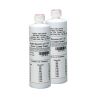Extech ExStik Refillable pH Meter
Features
- Automatic temperature compensation
- Simultaneous display of pH and temperature
- Display indicates when the reading is stabilized
- Expedited repair and warranty service
- Lifetime technical support
- More
Overview
The Extech ExStick Refillable pH Meter measures pH in liquids, semi-solids, and solids. The fresh reference solution maintains high accuracy and eliminates concern for shelf life.
Maintenance
The CAL alert lets users know when it's time to calibrate, and the RENEW function for when it's time to replace the electrode.
Mechanics
The memory records and recalls 15 sequentially tagged readings which allow the detection of changes over time. The analog bargraph is displayed on the LCD to show trends in acidity or alkalinity. The meter takes 1, 2, or 3-point calibration that automatically recognizes buffer solutions. Additional meter options include data hold, automatic power off, and low battery indication. The waterproof design floats in water and protects the meter in wet environments. The meter also adjusts using automatic temperature compensation.
- pH range: 0 to 14pH
- pH resolution: 0.01pH
- pH Accuracy: ±0.01pH
- Temperature range: 23 to 194°F (-5 to 90°C)
- Temperature resolution: 0.1°
- Temperature accuracy: ±1.8°F/±1°C
- Measurement storage: 15 tagged (numbered) readings
- Operating conditions: 32 to 122 F (0 to 50 C) /< 80% RH
- Display: multifunction LCD with bargraph
- Dimensions: 1.4 x 6.8 x 1.6" (35.6 x 172.7 x 40.6mm)
- Weight: 3.8oz (110g)
- Warranty: 1 year (meter), 6 month conditional (electrode)
- (1) ExStick meter
- (1) Flat surface refillable pH electrode
- (1) 1.5mL bottle KCI
- (2) Reference junctions
- (2) Removal tools
- (1) Protective sensor cap
- (1) Sample cup with cap
- (4) 3V CR2032 button batteries
- (1) 48" (1.2m) neckstrap
In The News
Ocean acidification: University of Washington's giant plastic bags help control research conditions
With oceans becoming more acidic worldwide, scientists are getting creative in designing experiments to study them. For example, one group at the University of Washington is using giant plastic bags to study ocean acidification. Each bag holds about 3,000 liters of seawater and sits in a cylinder-like cage for stability. The group at UW, made up of professors and students, is controlling carbon dioxide levels in the bags over a nearly three-week period, during which they are looking at the effects of increased acidity on organisms living near the San Juan Islands. “These mesocosms are a way to do a traditional experiment you might do in a lab or classroom,” said Jim Murray, professor of oceanography at the University of Washington.
Read MoreNOAA Alaska buoy network to monitor North Pacific ocean acidification
National Oceanic and Atmospheric Administration scientists detected signs of ocean acidification in the waters that hold the vulnerable and valuable fisheries of the North Pacific off the coast of Alaska, but they only had a snapshot of the action. “We know that in this place were important commercial and subsistence fisheries that could be at risk from ocean acidification,” said Jeremy Mathis, a NOAA Pacific Marine Environmental Laboratory researcher and professor at the University of Alaska Fairbanks. To understand how ocean acidification affects the North Pacific, NOAA scientists created a mooring network that collects constant in situ data on parameters contributing to acidification. They hope it will reveal seasonal trends and patterns left out by their snapshots.
Read MoreSource Water Monitoring in Albany, New York: Tracing Water Quality throughout Tributaries
Thousands of US cities pull their drinking water from natural source waters like reservoirs, rivers, and streams, making overall watershed health a key consideration for water providers. In Albany, New York, the Albany Department of Water and Water Supply delivers drinking water to over 100,000 residents as well as monitors and manages the larger drinking water supply watershed. Hannah Doherty, Environmental Specialist at the Albany Department of Water and Water Supply , spends her days working with a small team to monitor the drinking supply and the connected water bodies. Doherty explains, “We’re the first to encounter the water that ends up being the drinking water.
Read More


















